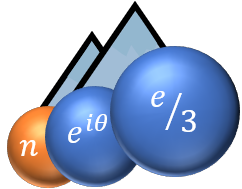Recent progress in fabrication of highly controllable single-electron transistor (SET) - based devices has opened new opportunities to study a wide range of strongly correlated phenomena. Particularly, due to the quantization of charge states in the quantum dot (QD), the SET provides a perfect platform for simulating various quantum-impurity models. Recently, a charge implementation of the multichannel Kondo model was designed as a hybrid metal-semiconductor SET formed in a 2DEG and operating in the integer quantum Hall regime [1,2]. In contrast to the original spin-1/2 impurity problem, the quantum pseudospin in the charge Kondo circuit is represented by two degenerate macroscopic charge states of the QD [3,4]. Together with the remarkable tunability of the conducting channels connecting the island, the device in [1,2] provides unprecedented access to the study of multichannel Kondo physics.
In this talk, I will address a question of how the low-temperature transport properties of the charge Kondo circuit change when the device from [1, 2] operates in the fractional quantum Hall regime with the filling factor v=1/m, where m is odd integer. For this, I consider the model when a large QD is strongly coupled to M leads via M single-mode quantum point contacts (QPCs). In case of two-terminal SET, when the problem is mapped onto the two-channel charge Kondo problem, it is predicted that the power of temperature correction to the conductance is determined by the fractional filling factor. For M>2, I examine the case in which (M-1) QPCs are fully open, reproducing a single-channel circuit coupled to a dissipative Ohmic environment. The SET device can be treated as the simulator of the Luttinger-liquid with an impurity, whose effective interaction parameter K=v(M-1)/M is determined by the filling factor and the number of open ballistic channels. The conductance scaling in the weak and strong tunnel regimes is used to discuss the low temperature transport behavior of the multi-channel single- and two-charge Kondo [5] circuits. A well-known correspondence between a one-dimensional edge excitation in the FQH effect and the Luttinger-liquid is utilized to study the influence of electron-electron interaction on quantum-impurity physics in various charge Kondo devices.
[1] Z. Iftikhar, S. Jezouin, A. Anthore, U. Gennser, F. D. Parmentier, A. Cavanna, and F. Pierre, Nature 526, 233 (2015).
[2] Z. Iftikhar, A. Anthore, A. K. Mitchell, F. D. Parmentier, U. Gennser, A. Ouerghi, A. Cavanna, C. Mora, P. Simon, and F. Pierre, Science 360, 1315 (2018).
[3] K. A. Matveev, Sov. Phys. JETP 72, 892 (1991).
[4] K. A. Matveev, Phys. Rev. B 51, 1743 (1995).
[5] W. Pouse, L. Peeters, C. L. Hsueh, U. Gennser, A. Cavanna, M. A. Kastner, A. K. Mitchell, and D. Goldhaber-Gordon, Nat. Physics 19, 492 (2023).

 PDF version
PDF version
